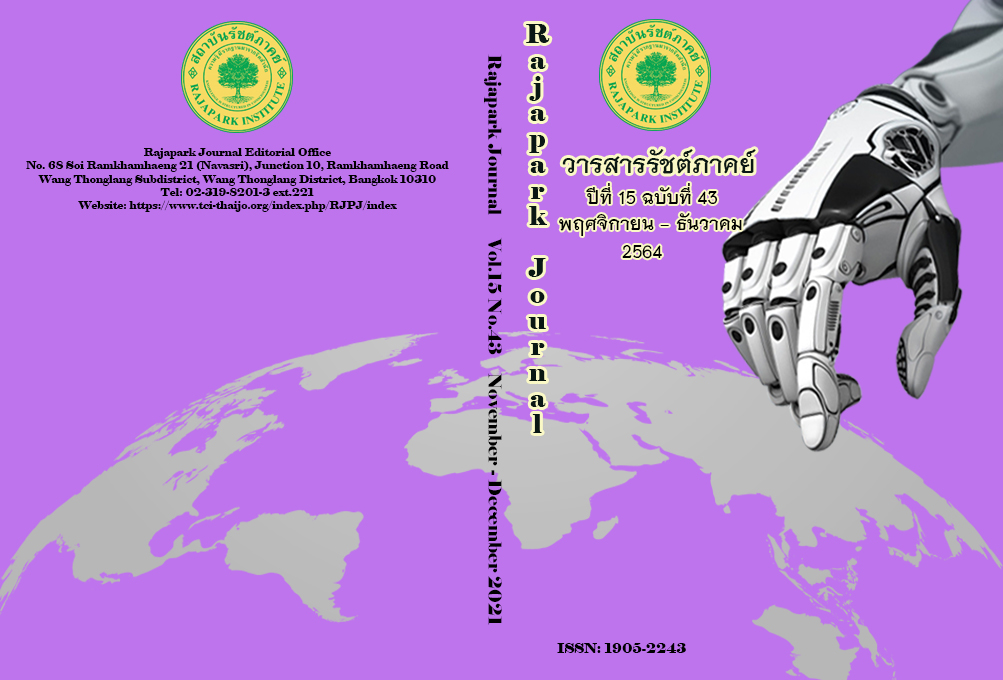Outcomes of Measures to Control Drinking Alcohol in Educational Institutions: A Case Study of Vocational Education College in Mueang District Suphanburi Province
Main Article Content
Abstract
The objectives of this research were 1) to study the outcomes of measures for the control of drinking alcohol in educational institutions 2) to study the factors that affect the control of drinking alcohol in educational institutions and 3) to study guidelines for improving measures for the control of drinking alcohol in educational institutions. The research is combined with Qualitative research and Quantitative research. The Qualitative research data collection instrument was interviewing format to analyzed by interpreting the study issues and the Quantitative research sample selection of 374 students by 4 Vocational Education colleges in Suphanburi Province the data analyzed questionnaires using statistics Frequency, percentage, mean, standard deviation, and Pearson Correction. The research results showed that: 1) the outcomes of measures for the control of drinking alcohol in educational institutions was at highest level 2) factors that affecting measures of alcohol control in educational institutions is the prohibition of alcohol advertising was at highest level, and 3) Guidelines to improve the alcohol control measures in schools to be effective is to have more rigorous enforcement of the law. There is an education in which students can refuse the solicitation of their peers to drink and have a bad attitude towards alcohol to know the poison and harm of alcohol create incentives to reduce, quit, and prevent relapse. Build acceptance for students to see the importance and self-worth for effective measures to control alcohol consumption in educational institutions
Article Details
Views and opinions appearing in the Journal it is the responsibility of the author of the article, and does not constitute the view and responsibility of the editorial team.
References
Announcement of the Alcoholic Beverage Control Board Re: Criteria, Methods and Conditions Regarding Labels of Alcoholic Drinks 2015. (2015, January 22). Government Gazette. Volume 132 Special Chapter 18 D. pp.6.
Announcement of the Prime Minister's Office Subject: Determination of places or areas forbidding the sale of alcoholic beverages around educational institutions 2015. (2015, October 22). Government Gazette. Volume 132 Special Chapter 263 D. pp.14.
Boriharn, P. (2006). Alcohol Drinking Behavior of Group Affiliated Female Teenage Students: A Case Study(Master of Education, Educational Psychology and Guidance). Chiang Mai University.
Center of Alcohol Studies. (2008). The 4th National Alcohol Conference Stop Alcohol Problem Crisis by Law and Regulation. Nonthaburi: Center of Alcohol Studies.
Chaimusik, C. (2007). Opinions on Thai Social Problems Affecting Crime Problems(Individual Study Document, Institute of Civil Service Development, Police, Superintendent Course, Class 57). Bangkok: Thai Royal Police.
Chisholm, M. E., & Ely, D. P. (1976). Media Personnel in Education: A Competency Approach. Englewood Cliffs, N.J.: Prentice-Hall.
Fromme, K., Wetherill, R., & Neal, D. (2010). Turning 21 and the Associated Changes in Drinking and Driving after Drinking Among College Students. Journal of American College Health, 59(1), 21-27. DOI: 10.1080/07448481.2010.483706
Hinkle, D. E. (2002). Applied Statistics for the Behavior Sciences (5th ed.). New York: Houghton Mifflin.
Hutapaet, B., & Suwannarat, K. (2003). Effects of Alcohol as a Contributing Factor to Domestic Violence(Research report). Bangkok: Women's Rights Protection Center, Friends of Women Foundation.
Nimaram, S. (2010). Attitude and Adopting Substance Beverage Alcohol Behavior Changes Mass Media of Women Teen-age in Amphoe Mueang Chiang Mai Province(Master of Arts, Communication Studies). Chiang Mai University.
Office of the Alcohol Control Committee. (2015). The framework of the 5-year Strategic Plan for Alcohol Control Operations. Retrieved from www.thaiantialcohol.com/documents/download/112
Road Safety Thailand. (2020). Summarize Report on the Performance of Preventing and Reducing Road Accidents During the New Year Festival 2020. Retrieved from http://roadsafety.disaster.go.th/inner.roadsafety-1.196/download/menu_7090/3850.1/
Royal Academy. (2003). Dictionary of the Royal Institute, 1999. Bangkok: Nanmeebooks.
Srisa-ard, B. (1992). Principles of Preliminary Research (3rd ed.). Bangkok: Suweeriyasan.
Teravecharoenchai, S. (1998). Drugs and Narcotics. Bangkok: Thai Wattana Panich.
Thai Health Promotion Foundation. (2005). Information to Reduce the Loss of Drunkenness. Retrieved from http://www.cas.or.th.
Thamarangsi, T. et al. (2013). Relationships on Drinking Behavior Alcohol and Trauma Admitted to the Emergency Department. Nonthaburi: Center of Alcohol Studies.
Waleewong, O., Thammarangsi, T., & Jankhotkaew, J. (2014). Alcohol’s Harm to Others in Thailand: Concept, Situation and Gap in Knowledge. Journal of Health Systems Research, 8(2), 111-119.
World Health Organization [WHO]. (2001). The Alcohol Use Disorders Identification Test: Guidelines for Use in Primary care, 2nd edition 2001. Retrieved from http://apps.who.int/iris/bitstream/handle/10665/67205/WHO_MSD_MSB_01.6a_tha.pdf
Yamane, T. (1973). Statistics: An Introductory Analysis (3rd ed.). New York: Harper & Row.
Youngkong, S. et al. (2007). Review of Alcohol Policies and the Role of the Thai Health Promotion Foundation in Reducing Alcohol Consumption Between 1997-2007 in Thailand. Retrieved from https://www.hitap.net/documents/20892


